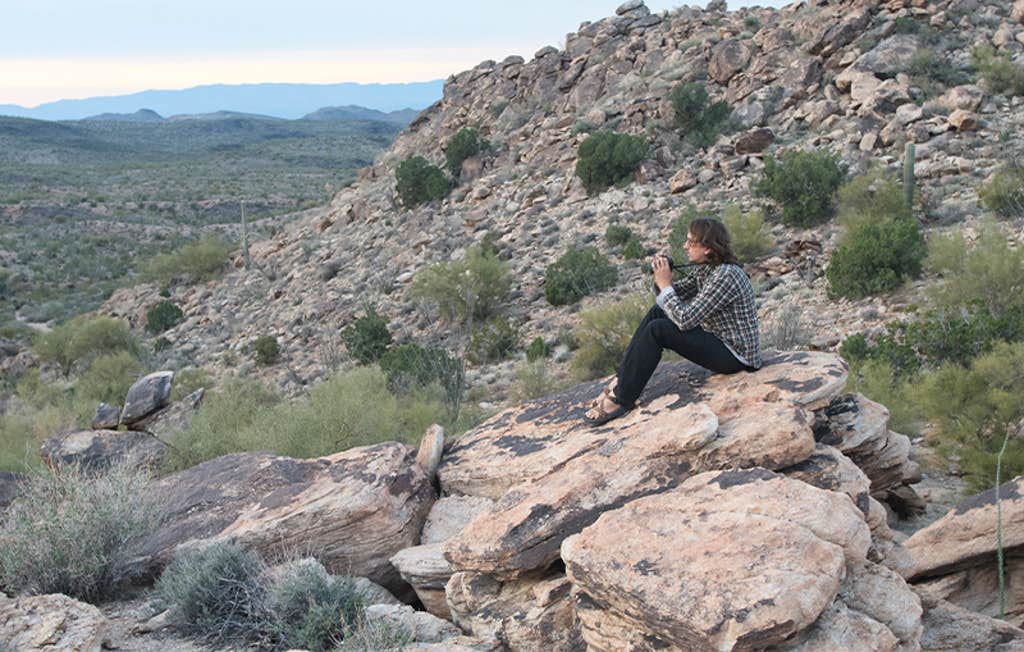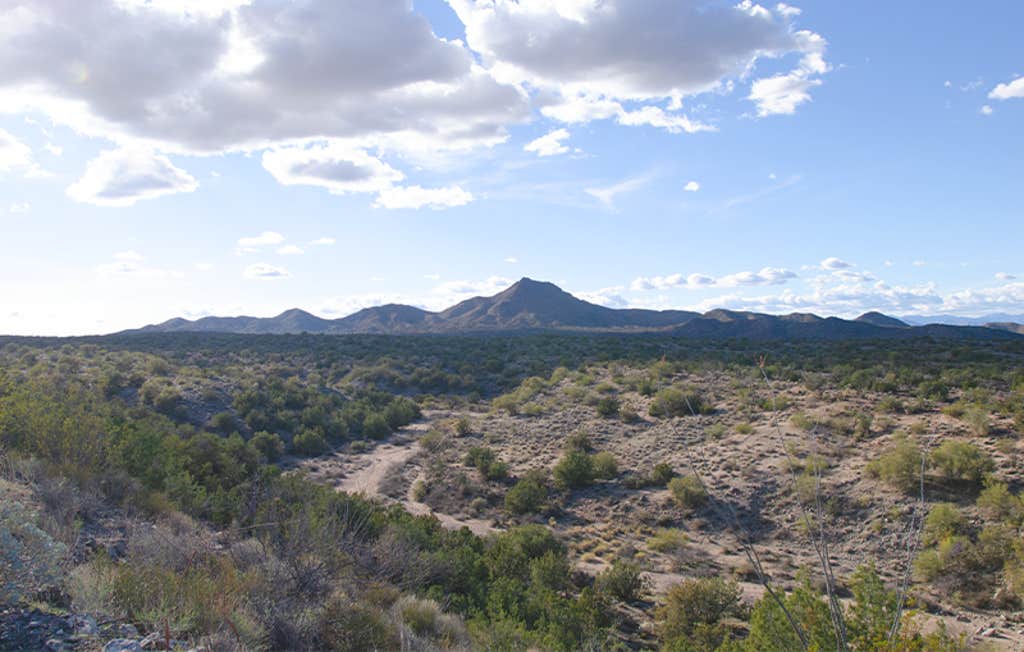Ten years ago, while camping in the Sonoran Desert, Erick Lundgren noticed something unusual: clusters of holes, several feet across and at least that deep, dug in a dry riverbed. Water pooled at the bottom. The holes were wells, dug by burros—better known as donkeys, but still called by their Spanish name in the American Southwest. They fascinated Lundgren.
In an otherwise parched landscape, the wells were unexpected oases. He wondered what other creatures might drink from them.
Lundgren, who at the time was a young biologist doing grunt work as a field technician on conservation projects, looked in the scientific literature for accounts of donkey-dug wells. He found none, which was not surprising. In their native East Africa, donkeys are critically endangered, with fewer than 600 remaining. There are hardly any to study. And in places like the United States Southwest, where donkey populations are descended from animals imported centuries ago to toil for Spanish colonists, most ecologists and conservation biologists—as well as land agency officials and wildlife managers and ranchers—generally considered them a scourge: invasive, destructive animals despoiling delicate ecosystems ill-adapted to their alien presence, overpopulated, in desperate need of eradication. Their hole-digging didn’t deserve attention.
They “do not play a functional role in our existing North American ecosystems,” declares The Wildlife Society in a statement emblematic of the conventional wisdom. They’re an invasive species and thus, “among the most widespread and serious threats to the integrity of native wildlife populations.” Lundgren, however, was not someone to accept convention on faith.

That had not always been the case. As a nature-loving kid and then a conservation biology-loving teen, he had learned that native species are good and nonnative species—those present because, at some point in history, humans moved them outside their previous range—are suspect. Whereas natives had evolved together into an intricately tangled community of life, nonnatives were interlopers; their ecological relationships tended to be fewer, poorer, and less life-sustaining. Some, freed from whatever checks and balances existed in their original homes, were destructive. These qualified as invasive. Killing them to protect ecological health was justifiable, even necessary.
One day, though, as he told his father about the dangers of Amur honeysuckle, an east Asian shrub now widespread in the eastern U.S., his dad said something that made Lundgren pause. “I wonder what they will become?” he asked, meaning: What ecological relationships might, with time and evolutionary pressure, form around these newcomers? That resonated with Lundgren. It exemplified the curiosity and open-mindedness he believed a biologist should have. Soon he came to think that the dichotomy between native and nonnative species was far messier than he had been taught.
Before moving to Arizona, Lundgren worked on an island off the coast of California where cats were being exterminated to protect endangered native birds and to reduce competition with foxes. (The foxes had, in fact, been introduced to the islands by precolonial peoples roughly 6,000 years ago—long enough ago to escape nonnative designation and also to become a distinct subspecies.) When the contents of their stomachs were examined, though, the cats turned out to subsist almost entirely on mice, while foxes were much more likely to eat the endangered birds. On another of these islands, conservationists had eradicated nonnative pigs—but the island’s resident pig-deprived golden eagles started eating foxes instead, necessitating the capture of the eagles.
Donkeys are a serious threat to native wildlife, declared the Wildlife Society.
The tensions and ambiguities Lundgren encountered are more common than one might think. In Micronesia, for example, purportedly nonnative monitor lizards were long targeted for eradication, but they proved to be a native species that reached the islands thousands of years before humans. In Mongolia, genetic studies of endangered Przewalski’s horses treasured as the last truly wild horses found them to be descendants of domesticated animals. Does it make sense to justify the killing of ostensibly nonnative mountain goats in Grand Teton National Park when, a few dozen miles away, they are accepted as native? And might nonnative species sometimes provide benefits to biodiversity, enriching webs of life in ways that a focus on nativity had ignored?
Lundgren had worked on a project in Hawaii, where native birds have been decimated by mosquito-borne malaria. In many forests nonnative birds now fulfill the ecological roles of their native counterparts, spreading seeds from which future forests will grow—yet the birds were killed as a matter of policy. Closer to home, in the Southwest, nonnative tamarisk trees were blamed for crowding out native riparian forests and the birds who lived in them, but tamarisks were simply better-adapted than natives to survive drought and human-caused water scarcity. Endangered southwestern willow flycatchers now depended on them.
Moreover, beyond his misgivings with newly murky rationales for killing some animals to help others, Lundgren was troubled by how it was done. It wasn’t that he couldn’t stomach death; he’d grown up hunting. But this sort of killing was so casual and dispassionate, as if being labeled invasive exempted those creatures from even the barest regard. “If life doesn’t matter, what the hell is conservation about?” Lundgren told me. Attempts at talking to his colleagues about this were met with stares.

By the time Lundgren decided to enroll in graduate school to study the interactions of native and nonnative species, these tensions had made their way into conservation discourse. “The practical value of the native-versus-alien species dichotomy in conservation is declining, and even becoming counterproductive,” wrote scientists in a landmark 2011 article entitled, “Don’t judge species on their origins.” This remains far from a universal sentiment, but it was now part of the conversation.
Simultaneously, the nascent compassionate conservation movement argued that the value of individual animal lives, and the ethical frameworks developed to make sense of how people treated captive and domestic animals, deserved a place in conversations about wild animals as well. Lundgren was a receptive audience for this, too, and it fed his discontent with reflexive nativism.
Though Lundgren’s graduate work started with seemingly esoteric studies of nonnative grasses, the question animating him was profound: What might people learn if they set aside preconceived notions about nativity and nonnativity and if they looked with clear eyes at what these species actually did?
He was, in short, the perfect person to notice the donkey wells.
This is how we ended up in Cattail Spring, about 140 miles northwest of Phoenix, the last few of which were traveled over a dirt track rendered nearly impassable by washouts during the rainy season. Cattail Spring is not a town but simply a place in the desert where water sometimes flows, and there Lundgren had placed trail cameras—the first of these he purchased with a crowdfunding campaign on IndieGoGo, underscoring how unconventional the research was—in the hopes of documenting donkey well life.
We arrived in late afternoon and made camp. As night fell, we talked about his frustrations with the dogmas of nativeness. He asked how I felt about eradications of introduced rodents on islands where they prey on seabird colonies. These are probably the most clear-cut cases of nonnative species having calamitous impacts on biodiversity, in which my own unease at killing some animals to protect others is overcome by an appreciation of those teeming colonies and the offshore reef ecosystems nourished by their feces. “That’s the question I have a hard time with,” he said. “Eradication on continents”—where populations are not neatly contained, and immigrating animals can quickly replace those who are killed—“I think is total bullshit. But islands are tough.”
To think of landscapes lacking these animals as intact is a sort of ecological amnesia.
For my own part, I wish the killing of those rats and mice were at least accompanied by a sense of what environmental ethicist Chelsea Batavia and ecologist Arian Wallach, a prominent compassionate conservationist who was Lundgren’s Ph.D. adviser, called “the moral residue of conservation.” It’s not the rodents’ fault that humans so heedlessly moved their ancestors around the globe; their appetite for seabird chicks would, if expressed by an acceptably native animal, be treated as an inevitable part of nature. To kill them, even for noble purposes, is to take innocent lives. “Conservationists should be emotionally responsive to the ethical terrain they traverse,” argued Batavia and Wallach in the journal Conservation Biology. “Feelings of grief are commensurate with acts of harm. Apathy or indifference is not.”
In all my years of reading and writing about the killing of invasive species, I’ve yet to encounter an expression of grief. To Batavia and Wallach, this is troubling because those feelings “act as tethers to abiding notions of what is good and of value in the world.” To turn them off—Lundgren recalled a colleague who cried after euthanizing a native bird with a broken wing but killed nonnative birds with barely a change in expression—risks harming something important in ourselves. Callousness can only be maintained at the cost of compassion.
Lundgren agreed with this. A casual attitude toward killing introduced species, he added, also made it easy to avoid less tractable but equally important problems, such as the overfishing that is now starving many seabirds. Moreover, even on islands, the impacts of nonnative species could be nuanced: An analysis of 300 Mediterranean islands containing both seabirds and invasive rats found that rats limited the abundance of only one seabird species, something the researchers called “an amazing conservation paradox.”
“We don’t give any credit to evolution,” Lundgren said. Perhaps, over time, newly introduced and long-native species would surprise us with their ability to coexist. Perhaps in many places they already were coexisting—but the ease of killing so-called invasives, and the habits of mind that reinforced, made it hard to see. I fell asleep to such thoughts beneath a starscape that, in the dry desert air and the absence of human habitation for miles in every direction, was as clear as any I’d ever seen.
At some indeterminate point in the night we were awakened by a nearby donkey’s braying, a sound that is easily lampooned—hee-haw!—but in that place was nothing less than majestic. Proud, even, anthropomorphism be damned, and fiercely independent.

At daybreak we found hoofprints: A group of donkeys had gathered a few hundred feet from our cots. Perhaps they had been curious about our presence; perhaps the bray was someone’s way of letting us know that this was their home. From a ridgeline we sipped coffee and watched the sun rise, bathing the valley below in the gentle glow that precedes the crucible of day. There were no donkeys in sight but their distant brays echoed off canyon walls and mingled with coyotes howling their night’s end.
“That’s the sound of the Pleistocene,” said Lundgren. By this he meant that until about 12,000 years ago—the end of the geological epoch more conversationally known as the Ice Age—the region was inhabited by a whole menagerie of large-bodied animals, among them camels, tapir, mammoths, and two species of wild horses, including one with an uncanny resemblance to donkeys. Like most of North America’s large animals, they were extirpated or driven extinct by a combination of climate change and human hunting.
Where megafauna still survive in their native ranges, though, they’re considered landscape engineers and keystone species whose ecological functions are uniquely tied to their size.
Research on them abounds: They disperse seeds across vast distances, distribute enormous quantities of nutrients in their dung and eventually their corpses, and create landscape-replenishing vegetative mosaics with their grazing. Through a long historical lens, then, their absence in the modern Southwest is both an aberration and a loss. To think of landscapes lacking them as being intact is a sort of ecological amnesia.
To Lundgren, the automatic perception of donkeys in terms of damage and alien origin reflects a failure to appreciate what megafauna do and a blindness to how conservation’s idealized baselines are actually missing an entire guild of creatures. They’re not identical to horses who once lived here, but their presence is far less strange than their absence. Lundgren identified a creosote bush for me. Creosote reproduces both through seeds and by cloning themselves; the oldest known colony is estimated to be nearly 12,000 years old. “It was one of the first plants to arrive at the end of the Ice Age,” he said. “It germinated with mammoths and camels around it, but it’s still here.”
After loading our packs, we set off for the springs. Our footsteps crunched on the rocky, mostly bare soil, though it was hardly barren.
The Sonoran Desert is one of the more biodiverse deserts on Earth, and as my northeastern eyes recognized few of the plants, Lundgren helpfully identified them for me: Crossosoma, prosaically known as ragged rockflower. Ocotillo, also called coachwhip, covered in spines that hinted at an evolutionary history of being eaten by large herbivores. A small yellow palo verde tree that had a very recent history of being eaten.
“Look at what burros did to this plant!” Lundgren exclaimed. They had somehow reached into branches that stretched well above our own heads and pulled them down, snapping them off the trunk. “How do you interpret that?” he continued. “It’s hard for that plant—but that’s what herbivores do. It’s unique, though. Nothing native is doing this now. But they used to do things like that.”
A few of the breaks were fresh; others, weathered. We were not looking at a single episode of feeding but instead many spread across the years, shaping the tree’s growth and, Lundgren suspects, effectively pruning the tree and stimulating the growth of tender new shoots that might be consumed by such animals as bighorn sheep.
“The question is, how do you approach this?” said Lundgren. “What lens do you take? There are slides from Arizona Game and Fish”—the state’s wildlife management agency—“that show images like this. The argument goes that native herbivores don’t have front incisors, but wild donkeys do. Therefore plants die. Which I think is kind of magical thinking. Plus they’re not dying. They’re getting browsed.”
Even so, I countered, wouldn’t these trees be more vulnerable to disease? Every browsed tree might not die, but more would than in the absence of donkeys. “Totally. That’s possible,” Lundgren answered. “But what does that mean? Is that good or bad? I have a hard time if a system changes from having topsoil to having no topsoil. But shifting the species composition? Or shifting the architecture of trees? Those are not clear-cut good and bad, I don’t think.” ![]()
Read Brandon Keim’s “3 Greatest Revelations” while writing his new book here.
Excerpted from Meet the Neighbors: Animal Minds and Life in a More-than-Human World by Brandon Keim. Copyright © 2024 by Brandon Keim. Used with permission of the publisher, W.W. Norton & Company, Inc. All rights reserved.
Lead photo by Brandon Keim
































